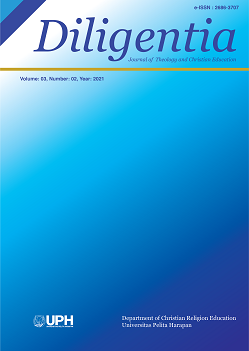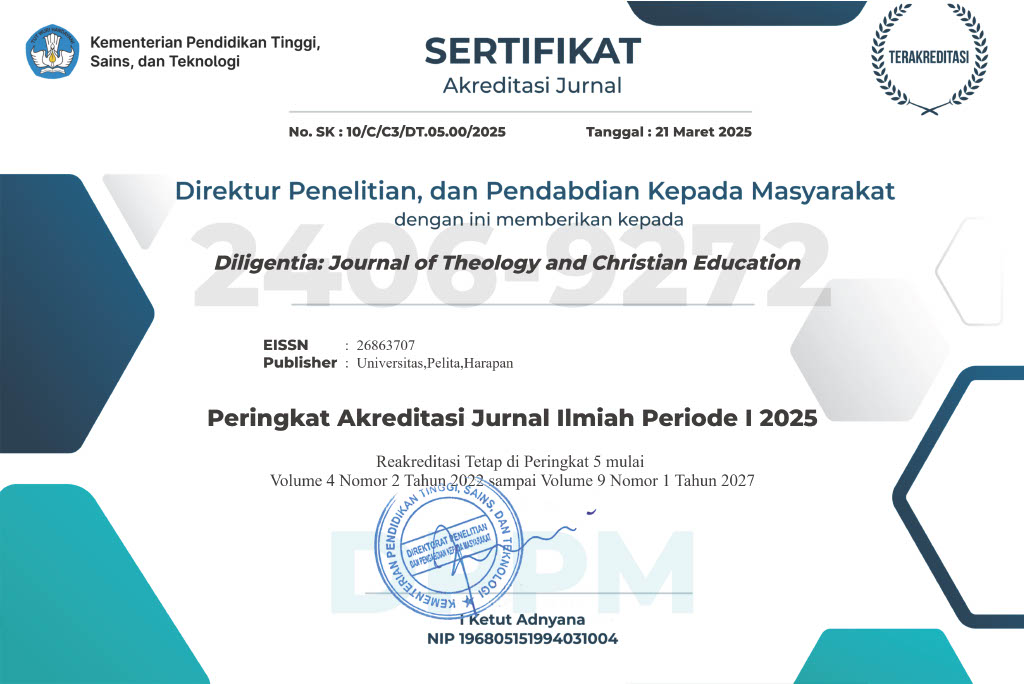Kajian Sistematik Teologi Mengenai Personalitas Iblis: Periode Media-Persia Sampai Kepada Injil [Systematic Theology Review on the Personhood of the Devil: Media-Persia Period up to the Gospel]
DOI:
https://doi.org/10.19166/dil.v3i2.3468Keywords:
Satan, Systematic Theology, PersonalityAbstract
The personality of Satan shares massive discussion together with fluctuation. The debate plays surround his figurity and personality. Biblical period denotes distinct knowledge. This essay attempts to delve and explore the personality of Satan in the period of Midian-Persian to New Testament time especially in the Gospel. This research is a qualitative work that occupying literatures, articles and books to re-construc the personality of Satan. As the result, the sociological infuences of Midian-Persian significantly contribute the knowledge of God’s people. They considers Satan as a symbol of war enmity. Further, in the Gospel period, Bible writters supply various of personality to describe Satan’s existence.
References
Ammerman, L.M dan J. Maritim. Melihat Ke Dalam Perjanjian Lama. Vol.3. Bandung, Indonesa: Kalam Hidup, 1979.
Banga, Aru dan I Ketut Enoh. “Tinjauan Teologis Tentang Iblis Dalam Injil Sinoptik.” Jurnal Jaffray 9, no.1 (2011): 86-108. https://doi.org/10.25278/JJ.v9i1.092.86-108
Baxter, J. Sidlow. Menggali Isi Alkitab 2. Ayub s/d Maleakhi. Jakarta, Indonesia: Yayasan Komunikasi Bina Kasih, 1998.
Benson, Clarence H. Pengantar Perjanjian Lama: Puisi dan Nubuat, Ayub-Maleakhi. Malang, Indonesia: Gandum Mas, 2004.
Berkhof, Louis. Teologi Sistematika. Vol.1. Surabaya, Indonesia: Momentum, 2007.
Brewer, H. Michael. Lessons from the Carpenter: An Apprentice Learns from Jesus. Colorado. CO: Crown Publishing Group, Water Brook Press, 2010.
Brosius, Maria. The Persians: An Introduction, PAW. London, UK: Routledge, 2006. https://doi.org/10.4324/9780203068151
Clements, R. E. The World of Ancient Israel: Sociological, Anthropological, and PoliticalPerspectives. Cambridge, UK: Cambridge University Press, 1995.
Evans, Tony. Teologi Allah: Allah Kita Maha Agung. Malang, Indonesia: Gandung Mas, 1999.
Firth, David G. dan Paul D. Wegner. Presence Power and Promise: The Role of the Spirit of God in the Old Testament. Nottiingham, United Kingdom: Inter-Varsity Press, 2011.
Fleming, D.E. The Legacy of Israel in Judah's Bible: History, Politics, and the Re-inscribing of Tradition. Cambridge, UK: Cambridge University Press, 2012. https://doi.org/10.1017/CBO9781139163033
Fuhrmann, Sebastian. “The Devil as (Convicted) Prosecutor: Some Ideas on the Devil in 1 Peter and Hebrews.” IDS 50, no.2 (2016): 1-4. https://doi.org/10.4102/ids.v50i2.2028
Glenn, Linda McDonald. Post humanism: The Future of Homo Sapiens. Farmington Hills, MI: Macmillan Reference USA Company, 2018.
Gener, Timoteo D. “Doing Contextual Systematic Theology in Asia: Challenges and Prospects.” JAET 22, no,1-2 (2018): 49-68.
Gintings, E.P., Djorelit Surbakti, dan Maria Ginting. Okultisme. Bandung, Indonesia: Bina Media Informasi.
Greggs, Tom. Theology Against Religion: Constructive Dialogues with Bonhoeffer and Barth. London, UK: T&T Clark, 2011.
Grujic, Petar V. “Bible and Monotheism.” European Journal of Science and Theology 7, no. 2, (2011): 49-62.
Herrenschmidt, Clarisse and Jean Kellens. “Daiva.” EIr 6, no. 6 (1993): 599-602, http://www.iranicaonline.org/articles/daiva-old-iranian-noun.
Hezser, Catherine. “Oral and Written Communication and Transmission of Knowledge in Ancient Judaism and Christianity.” Oral Tradition 25, no. 1 (2010): 75-92. https://doi.org/10.1353/ort.2010.0003.
Janowski, B. “The Person in Ancient Israel: Basic Statement of Old Testament Anthropology.” Zeitschrift fuer Theologie und Kirche 102, 143-175, 2005. https://doi.org/10.1628/004435405774478224
Jonker, Louis C. Defining All-Israel in Chronicles: Multi-Levelled Identity Negotiation in Late Persian Period Yehud. Vol.106. Tübingen, Germany: Mohr Siebeck, 2016. https://doi.org/10.1628/978-3-16-154596-2
Jonker, Louis C. “Satan Made Me Do It!” The Development of a Satan Figure as Social-Theological Diagnostic Strategy from the late Persian Imperial Era to Early Christianity.” Old Testament Essay 30, no.2(2017): 348-366. https://doi.org/10.17159/2312-3621/2017/v30n2a10
Kwon, Soon-Hee dan Jong-Keung Lee “Activities to Longevity in a Perspective of the Ancient Near East: Based on the Lives of Adad-Guppi in the Neo-Babylonian Empire, Daniel in the Old Testament, and Anna in the New Testament.” The Journal of the KoreaContents Association 15, no. 7 (2015). https://doi.org/10.5392/JKCA.2015.15.07.643.
Maggang, Elia. “Menampakan Corak Biru Kekristenan Indonesia.” Indonesian Journal of Theology 7, no.2 (2019): 162-188. https://doi.org/10.46567/ijt.v7i2.149
Malina, Bruce J. The New Testament World, Insights from Cultural Anthropology. Louisville, KY: Westminster John Knox Press, 2001.
Mills, Mary E. Images of God in the Old Testament. London, UK: Cassell Welington House, 1998.
Niditch, Susan. “Folklore and the Hebrew Bible: Interdisciplinary Engagement and New Directions.” Humanities 7, no. 6 (2018): 1-20. https://doi.org/10.3390/h7010006.
Orr, William W. Misteri Iblis. Bandung, Indonesia: Kalam Hidup, 2000.
Orr, William W. Setan Ada Atau Tidak.? Bandung, Indonesia: Kalam Hidup, 1987.
Pagels, Elaine. The Origin of Satan: How Christians Demonized Jews, Pagans, and Heretics. London, UK: Penguin Vintage, 2011.
Pierce, Chad T. Satan and Related Figures,ed. John J. Collins and Daniel C. Harlow. The Eerdmans Dictionary of Early Judaism. Grand Rapids, MI: Eerdmans, 2010.
Romer, Thomas C. “Yhwh, the Goddess and Evil: Is ”˜monotheism’ an Adequate Concept to Describe the Hebrew Bible’s Discourses About the God of Israel?” Verbum et Ecclesia 34, no. 2 (2013):1-5. https://doi.org/10.4102/ve.v34i2.841
Schmitt, Rüdiger. The Old Persian Inscriptions of Naqsh-I Rustam and Persepolis, Corpus Inscriptionum Iranicarum ½. London, UK: School of Oriental and African Studies, 2000.
Spangenberg, Izak. “A Brief History of Belief in the Devil (950 BCE - 70 CE).” Studie Historiae Ecclesiasticae 39, no. 1 (2013): 1-20.
Sperling, Shalom David. A Companion to the Ancient Near East. Oxford, UK: John Wiley and Sons, Blackwell Publishing, 2008.
Suh, Sung M. Injil dan Penyembahan Nenek Moyang. Yogyakarta, Indonesia: Penerbit Media Pressindo, 2001.
Szreter, Adam. “Cronje Names Devil Who Made Him Do It.” The Guardian, 2000. https://www.theguardian.com/sport/2000/jun/02/cricket.
Tolanda, Irvin. “Kedaulatan Allah atas Iblis Berdasarkan Kitab Ayub Pasal 1 dan 2 Serta Relevansinya Dalam Kehidupan Orang Percaya.” Jurnal Jaffray 9, no. 2 (2011):53-89. http://dx.doi.org/10.25278/jj71.v9i2.96.
Tong, Stephen. Roh Kudus, Suara Hati Nurani dan Setan. Surabaya, Indonesia: Momentum, 2009.
Wagner, C. Peter. Roh-roh Teritorial. Jakarta, Indonesia: Immanuel, 1994.
Walters, James William. What is a Person? An Ethical Exploration. IL: University of Illionis Press, 1997.
Wojciechowski, Michal. The Bile and Economics. Szeged, Hungarian: JATE Press, 2014.
Waters, Matt W. Ancient Persia: A Concise History of the Achaemenid Empire, 550-330 BCE. Cambridge, UK: Cambridge University Press, 2014. https://doi.org/10.1017/CBO9780511841880
Downloads
Published
How to Cite
Issue
Section
License
Authors who publish with this journal agree to the following terms:
1) Authors retain copyright and grant the journal right of first publication with the work simultaneously licensed under a Creative Commons Attribution License (CC-BY-SA 4.0) that allows others to share the work with an acknowledgement of the work's authorship and initial publication in this journal.
2) Authors are able to enter into separate, additional contractual arrangements for the non-exclusive distribution of the journal's published version of the work (e.g., post it to an institutional repository or publish it in a book), with an acknowledgement of its initial publication in this journal.
3) Authors are permitted and encouraged to post their work online (e.g., in institutional repositories or on their website). The final published PDF should be used and bibliographic details that credit the publication in this journal should be included














